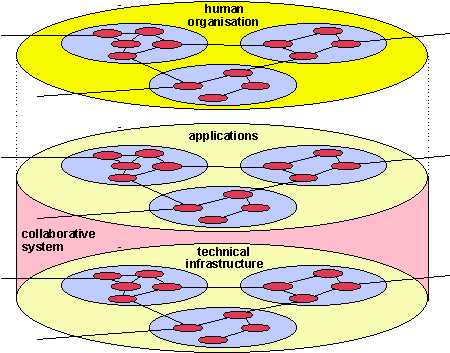
Vision
3. IT In Organisations |
3.1 Introduction
The growing supply of new information technology (IT) and the continuous growth of networks will lead to the continuing growth of the role IT plays in organisations. Current developments in this area will lead to the creation of innovative applications, which will support the business operations in a stronger and wider sense. This chapter looks at the developments from a technology angle. It gives an impression of the growing significance of IT and networks in organisations and it describes a number of examples of new applications.
The development of networks greatly influences the form of the applications. The subject of 'network systems' is therefore thoroughly discussed in this chapter. Network systems offer an excellent infrastructure to support the work and collaboration of people in an organisation. For network systems of which the applications are specifically aimed at supporting the collaboration of people in organisations, we use the name Collaborative Systems.
A collaborative system is a network system in two layers. The bottom layer is the technical infrastructure, consisting of a network of computers (workstations and servers) and other technical resources, such as computer-controlled machines and other equipment. The second layer is a network of applications carried by the technical infrastructure.

Figure 3.1 A collaborative system. The human organisation that uses the collaborative system forms a third layer. By means of the collaborative system, people perform their tasks, such as working with data, communicating with each other and controlling their mutual collaboration. The inter-human organisation itself is a network of people that collaborate in all kinds of formal and informal co-operation.
Seen from a distance, the conglomerate of business processes a company executes by means of a collaborative system is a close co-operation between three layers, each being a collaboration of either people, applications or hardware.
Section 3.2 mainly discusses the collaborative aspect. It demonstrates how the human organisation of the top layer can use the applications and the technical infrastructure of the two lower layers for co-operation. This is described for:
- co-operation between companies or autonomous business units;
- informal collaboration between people, for instance in teams and interest groups.
For all these forms of co-operation we mainly focus on the organic aspect of the organisation, that of people collaborating in organisations flexibly and with mutual consultation.
In section 3.3 the accent shifts from the organisational angle to the angle of information technology. The emphasis is on the support IT applications give to people in monitoring and executing specific business processes. We demonstrate various ways in which IT helps people perform their tasks. The emphasis is mainly on formally prescribed business processes and IT applications. These processes also prescribe to a large extent how people are supposed to do their work. This underlines the mechanistic aspect of organisations. We will, however, show that formally prescribed business processes can be organised in a very flexible way, in spite of their 'mechanistic' nature.